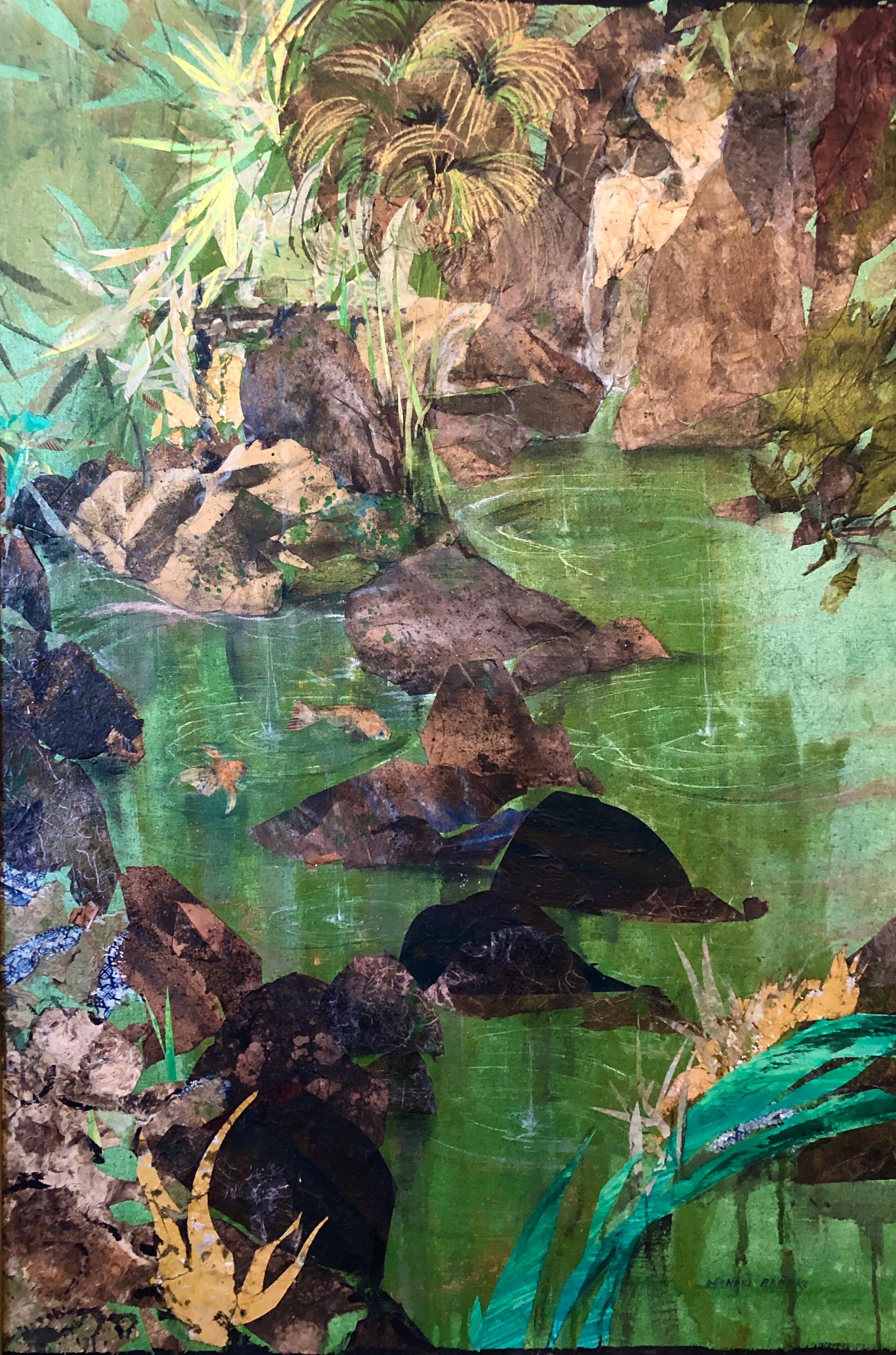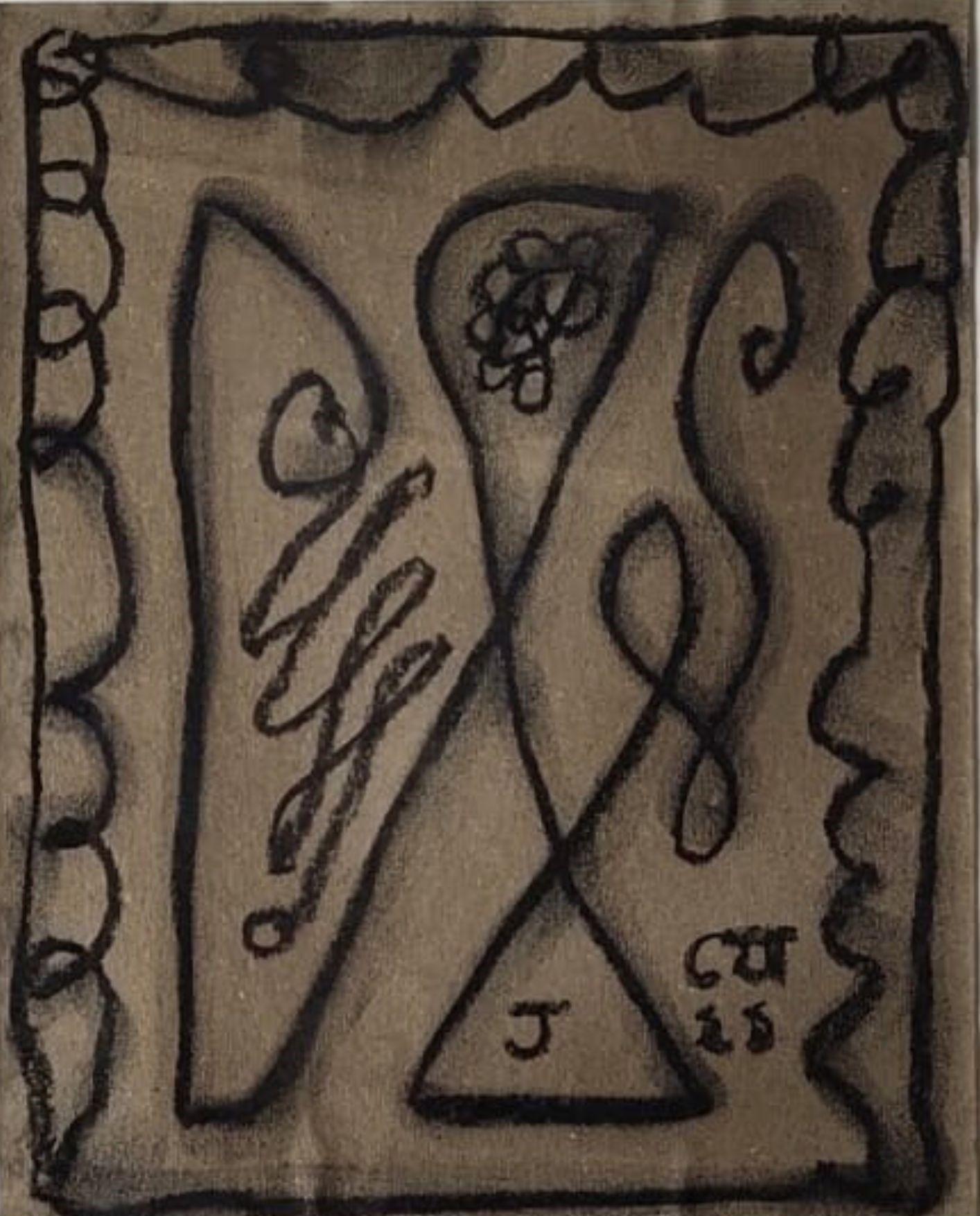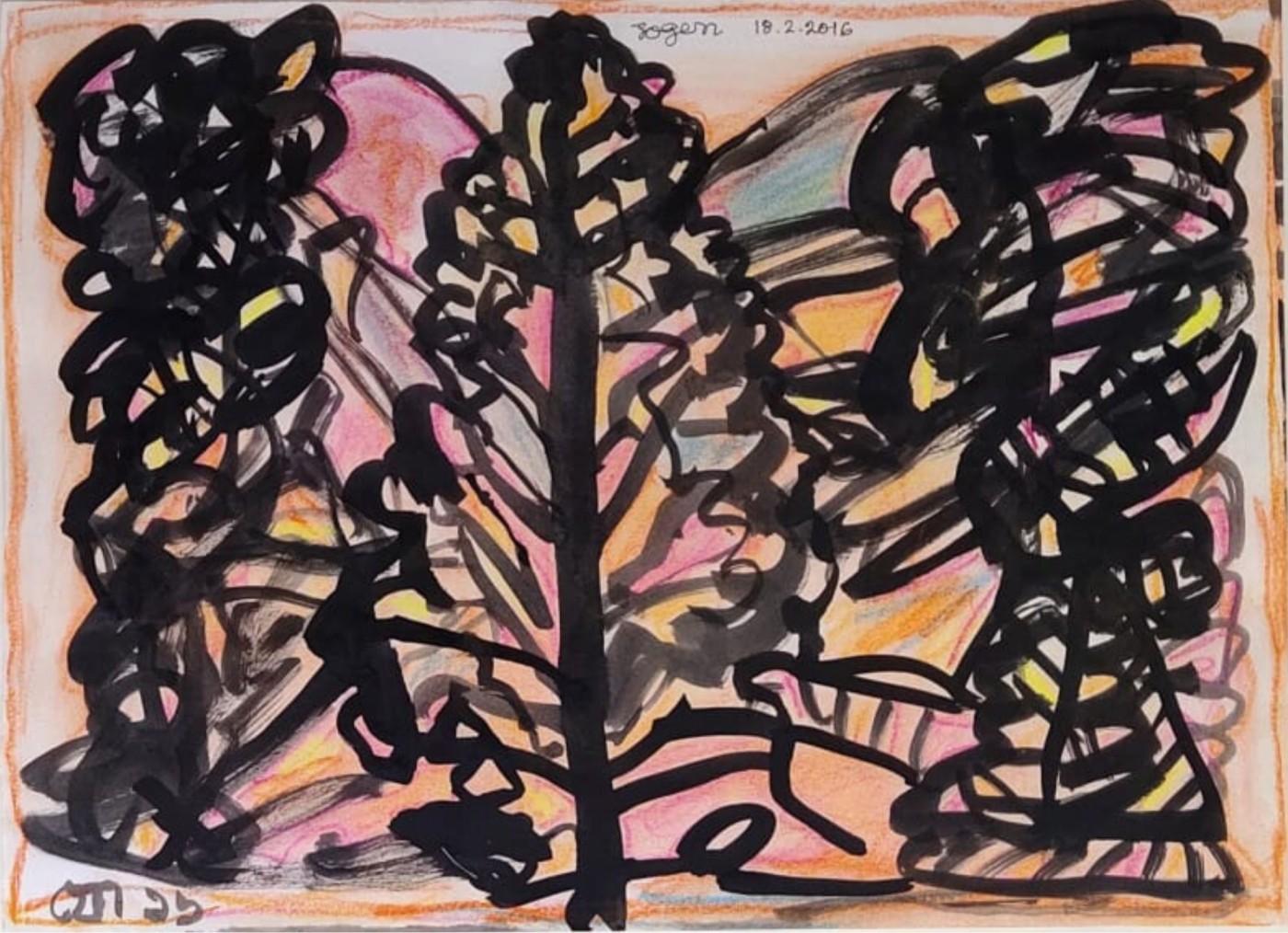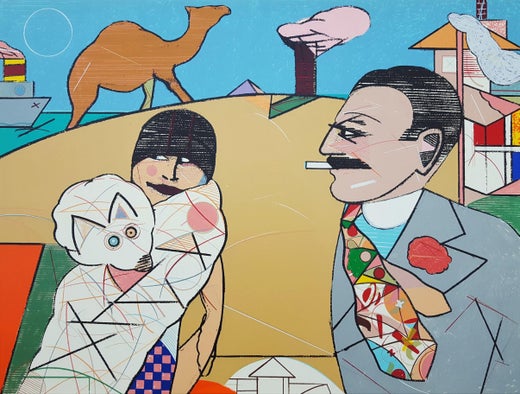Items Similar to Bulldog Drummond and the Great Coca-Cola Mystery by Richard Merkin
Want more images or videos?
Request additional images or videos from the seller
Richard MerkinBulldog Drummond and the Great Coca-Cola Mystery by Richard Merkin1965
1965
About the Item
An iconic mixed media example of Richard Merkin's art.
Bulldog Drummond and the Great Coca-Cola Mystery (1965)
Mixed media on paper
51" x 33"
53" x 35" x 2" framed
Signed "Merkin" lower right. Dated and titled verso on Obelisk Gallery label.
Provenance: Obelisk Gallery, Boston, 1967 (label verso)
Ex. Coll. Finch College Museum of Art (label verso) – sold when the museum closed in 1983
Private Collection, Purchase, NY 1983-1994
About this artist: Richard Merkin’s vibrant painting career was characterized by a blend of popular culture, everyday life, humor, and personal insights. He attended Syracuse University before pursuing graduate studies in art at Michigan State University and the Rhode Island School of Design, where he proceeded to teach drawing and painting for forty-two years. Numerous materials on his work and teaching career were admitted to the RISD Archives.
Merkin was born in Brooklyn, New York in 1938, and established his art career there after returning to the city in 1967. He enjoyed regular showings at the Terry Dintenfass Gallery, and exhibited at the Obelisk Gallery, Boston, the DeCordova Museum, and as part of the Boston Arts Festival and Rhode Island Arts Festival. He was deeply inspired by the lively paintings of R. B. Kitaj, and frequently worked in a collage or assemblage style. Merkin specialized in capturing popular scenes from the 1920s, 1930s, and 1940s, and created portraits of cultural luminaries such as Joan Didion and Fran Lebowitz.
As a well-known dandy, Merkin worked with Manhattan tailor Vincent Nicolosi and associated with Manhattanites Alan Flusser, Thomas Wolfe, Eddie Hayes and Bobby Short. He authored the column “Merkin on Style” for Gentlemen’s Quarterly from 1988 to 1991, became a Contributing Editor for Vanity Fair in 1986. He regularly contributed illustrations to The New Yorker, Harper’s Bazaar, and The New York Times, and illustrated a book on African-American baseball leagues. He also maintained a claim to fame as part of the cover image from the Beatles’ Sergeant Pepper’s Lonely Hearts Club album, where he was pictured near Mae West, Carl Jung, and Bob Dylan.
Merkin eventually moved to Croton-on-Hudson, New York, where he died at the age of seventy. During his lifetime he was honored with the 1962-1963 Louis Comfort Tiffany Foundation Fellowship in Painting, and received the Richard and Hinda Rosenthal Foundation Award from the National Institute of Arts and Letters in 1975. He was also the recipient of prizes from the Providence Art Club Painting Annual in 1965, and the Silvermine Guild in 1963.
Written by Zenobia Grant Wingate
- Creator:Richard Merkin (1938 - 2009, American)
- Creation Year:1965
- Dimensions:Height: 51 in (129.54 cm)Width: 30 in (76.2 cm)
- Medium:
- Movement & Style:
- Period:
- Condition:Very good condition, appropriate for the age of this artwork.
- Gallery Location:Hudson, NY
- Reference Number:
Richard Merkin
Richard Merkin’s (1938 – September 5, 2009) work conjures up scenes that evoke the raucous spirit of the 1920’s, 30’s and 40’s. In his witty, often eccentric illustrations, Merkin depicts movie stars, jazz musicians, sports heroes and literary impresarios co-mingling with more personal references. In his highly stylized approach to the figure, Merkin privileges color relationships, balance and juxtaposition over strictly literal descriptions of his subjects. And humor; there’s always humor.
About the Seller
5.0
Vetted Seller
These experienced sellers undergo a comprehensive evaluation by our team of in-house experts.
Established in 1973
1stDibs seller since 2023
5 sales on 1stDibs
Typical response time: 1 hour
- ShippingRetrieving quote...Ships From: Hudson, NY
- Return PolicyThis item cannot be returned.
More From This SellerView All
- P.F.P. abstract oil collage by Bill SaylorLocated in Hudson, NYP.F.P. (2011) Oil on canvas with collage Titled, signed and dated "P.F.P. / Bill Saylor / 2011" verso on canvas. Exhibited 2017 in "Animal Farm" a group exhibition at The Brant Foun...Category
2010s Abstract Abstract Paintings
MaterialsCanvas, Mixed Media, Oil
- Pyromaniac's Pyre mixed media work by Mary Spencer NayLocated in Hudson, NYSigned and dated "Mary Spencer Nay '74" lower left. Titled "Pyromaniac's Pyre" verso. Exhibited: 1976-1977 "Mary Spencer Nay: Recent and Retrospective Works". J.B. Speed Art Museum...Category
1970s Modern Abstract Paintings
MaterialsFabric, Canvas, Rubber, Wood, Oil
- Inevitable Day – Birth of the Atom oil and tempera painting by Julio De DiegoBy Julio de DiegoLocated in Hudson, NYJulio De Diego’s Atomic Series paintings made an extraordinary statement regarding the shock and fear that accompanied the dawn of the nuclear age. In the artist’s own words, “Scientists were working secretly to develop formidable powers taken from the mysterious depths of the earth - with the power to make the earth useless! Then, the EXPLOSION! . . . we entered the Atomic Age, and from there the neo-Atomic war begins. Explosions fell everywhere and man kept on fighting, discovering he could fight without flesh.” To execute these works, De Diego developed a technique of using tempera underpainting before applying layer upon layer of pigmented oil glazes. The result is paintings with surfaces which were described as “bonelike” in quality. The forms seem to float freely, creating a three-dimensional visual effect. In the 1954 book The Modern Renaissance in American Art, author Ralph Pearson summarizes the series as “a fantastic interpretation of a weighty theme. Perhaps it is well to let fantasy and irony appear to lighten the devastating impact. By inverse action, they may in fact increase its weight.” Bibliography Art in America, April 1951, p.78 About this artists: Julio De Diego crafted a formidable persona within the artistic developments and political struggles of his time. The artist characterized his own work as “lyrical,” explaining, “through the years, the surrealists, the social-conscious painters and the others tried to adopt me, but I went my own way, good, bad or indifferent.” [1] His independence manifested early in life when de Diego left his parent’s home in Madrid, Spain, in adolescence following his father’s attempts to curtail his artistic aspirations. At the age of fifteen he held his first exhibition, set up within a gambling casino. He managed to acquire an apprenticeship in a studio producing scenery for Madrid’s operas, but moved from behind the curtains to the stage, trying his hand at acting and performing as an extra in the Ballet Russes’ Petrouchka with Nijinsky. He spent several years in the Spanish army, including a six-month stretch in the Rif War of 1920 in Northern Africa. His artistic career pushed ahead as he set off for Paris and became familiar with modernism’s forays into abstraction, surrealism, and cubism. The artist arrived in the U.S. in 1924 and settled in Chicago two years later. He established himself with a commission for the decoration of two chapels in St. Gregory’s Church. He also worked in fashion illustration, designed magazine covers and developed a popular laundry bag for the Hotel Sherman. De Diego began exhibiting through the Art Institute of Chicago in 1929, and participated in the annual Chicago Artists Exhibitions, Annual American Exhibitions, and International Water Color Exhibitions. He held a solo exhibition at the Art Institute of Chicago in the summer of 1935. Though the artist’s career was advancing, his family life had deteriorated. In 1932 his first marriage dissolved, and the couple’s young daughter Kiriki was sent to live with friend Paul Hoffman. De Diego continued to develop his artistic vocabulary with a growing interest in Mexican art. He traveled throughout the country acquainting himself with the works of muralists such as Carlos Merida, and also began a collection of small native artifacts...Category
1940s American Modern Abstract Paintings
MaterialsMasonite, Oil, Tempera
- St. Atomic oil and tempera painting by Julio de DiegoBy Julio de DiegoLocated in Hudson, NYJulio De Diego’s Atomic Series paintings made an extraordinary statement regarding the shock and fear that accompanied the dawn of the nuclear age. In the artist’s own words, “Scientists were working secretly to develop formidable powers taken from the mysterious depths of the earth - with the power to make the earth useless! Then, the EXPLOSION! . . . we entered the Atomic Age, and from there the neo-Atomic war begins. Explosions fell everywhere and man kept on fighting, discovering he could fight without flesh.” To execute these works, De Diego developed a technique of using tempera underpainting before applying layer upon layer of pigmented oil glazes. The result is paintings with surfaces which were described as “bonelike” in quality. The forms seem to float freely, creating a three-dimensional visual effect. In the 1954 book The Modern Renaissance in American Art, author Ralph Pearson summarizes the series as “a fantastic interpretation of a weighty theme. Perhaps it is well to let fantasy and irony appear to lighten the devastating impact. By inverse action, they may in fact increase its weight.” Exhibited 1950 University of Illinois at Urbana "Contemporary American Painting" 1964 Marion Koogler McNay Art Institute, San Antonio, Texas This work retains its original frame which measures 54" x 36" x 2". About this artist: Julio De Diego crafted a formidable persona within the artistic developments and political struggles of his time. The artist characterized his own work as “lyrical,” explaining, “through the years, the surrealists, the social-conscious painters and the others tried to adopt me, but I went my own way, good, bad or indifferent.” [1] His independence manifested early in life when de Diego left his parent’s home in Madrid, Spain, in adolescence following his father’s attempts to curtail his artistic aspirations. At the age of fifteen he held his first exhibition, set up within a gambling casino. He managed to acquire an apprenticeship in a studio producing scenery for Madrid’s operas, but moved from behind the curtains to the stage, trying his hand at acting and performing as an extra in the Ballet Russes’ Petrouchka with Nijinsky. He spent several years in the Spanish army, including a six-month stretch in the Rif War of 1920 in Northern Africa. His artistic career pushed ahead as he set off for Paris and became familiar with modernism’s forays into abstraction, surrealism, and cubism. The artist arrived in the U.S. in 1924 and settled in Chicago two years later. He established himself with a commission for the decoration of two chapels in St. Gregory’s Church. He also worked in fashion illustration, designed magazine covers and developed a popular laundry bag for the Hotel Sherman. De Diego began exhibiting through the Art Institute of Chicago in 1929, and participated in the annual Chicago Artists Exhibitions, Annual American Exhibitions, and International Water Color Exhibitions. He held a solo exhibition at the Art Institute of Chicago in the summer of 1935. Though the artist’s career was advancing, his family life had deteriorated. In 1932 his first marriage dissolved, and the couple’s young daughter Kiriki was sent to live with friend Paul Hoffman. De Diego continued to develop his artistic vocabulary with a growing interest in Mexican art. He traveled throughout the country acquainting himself with the works of muralists such as Carlos Merida, and also began a collection of small native artifacts...Category
1940s American Modern Abstract Paintings
MaterialsMasonite, Oil, Tempera
- The Magician oil and tempera painting by Julio de DiegoBy Julio de DiegoLocated in Hudson, NYJulio De Diego’s Atomic Series paintings made an extraordinary statement regarding the shock and fear that accompanied the dawn of the nuclear age. In the artist’s own words, “Scientists were working secretly to develop formidable powers taken from the mysterious depths of the earth - with the power to make the earth useless! Then, the EXPLOSION! . . . we entered the Atomic Age, and from there the neo-Atomic war begins. Explosions fell everywhere and man kept on fighting, discovering he could fight without flesh.” To execute these works, De Diego developed a technique of using tempera underpainting before applying layer upon layer of pigmented oil glazes. The result is paintings with surfaces which were described as “bonelike” in quality. The forms seem to float freely, creating a three-dimensional visual effect. In the 1954 book The Modern Renaissance in American Art, author Ralph Pearson summarizes the series as “a fantastic interpretation of a weighty theme. Perhaps it is well to let fantasy and irony appear to lighten the devastating impact. By inverse action, they may in fact increase its weight.” Exhibited 1964 Marion Koogler McNay Art Institute, San Antonio, Texas This work retains its original frame which measures 54" x 42" x 2" About this artist: Julio De Diego crafted a formidable persona within the artistic developments and political struggles of his time. The artist characterized his own work as “lyrical,” explaining, “through the years, the surrealists, the social-conscious painters and the others tried to adopt me, but I went my own way, good, bad or indifferent.” [1] His independence manifested early in life when de Diego left his parent’s home in Madrid, Spain, in adolescence following his father’s attempts to curtail his artistic aspirations. At the age of fifteen he held his first exhibition, set up within a gambling casino. He managed to acquire an apprenticeship in a studio producing scenery for Madrid’s operas, but moved from behind the curtains to the stage, trying his hand at acting and performing as an extra in the Ballet Russes’ Petrouchka with Nijinsky. He spent several years in the Spanish army, including a six-month stretch in the Rif War of 1920 in Northern Africa. His artistic career pushed ahead as he set off for Paris and became familiar with modernism’s forays into abstraction, surrealism, and cubism. The artist arrived in the U.S. in 1924 and settled in Chicago two years later. He established himself with a commission for the decoration of two chapels in St. Gregory’s Church. He also worked in fashion illustration, designed magazine covers and developed a popular laundry bag for the Hotel Sherman. De Diego began exhibiting through the Art Institute of Chicago in 1929, and participated in the annual Chicago Artists Exhibitions, Annual American Exhibitions, and International Water Color Exhibitions. He held a solo exhibition at the Art Institute of Chicago in the summer of 1935. Though the artist’s career was advancing, his family life had deteriorated. In 1932 his first marriage dissolved, and the couple’s young daughter Kiriki was sent to live with friend Paul Hoffman. De Diego continued to develop his artistic vocabulary with a growing interest in Mexican art. He traveled throughout the country acquainting himself with the works of muralists such as Carlos Merida, and also began a collection of small native artifacts...Category
1940s American Modern Abstract Paintings
MaterialsMasonite, Oil, Tempera
- Spring Landscape acrylic and pastel painting by Fred MartinBy Fred MartinLocated in Hudson, NYExhibited: 1973 San Francisco Museum of Art 2003 Oakland Museum of California "Fred Martin Retrospective" A native Californian, Fred Martin was born...Category
1970s American Modern Abstract Paintings
MaterialsMasonite, Pastel, Acrylic
You May Also Like
- Large Canadian Mexican Modernist Figurative Abstract Collage Painting LandscapeBy Leonard BrooksLocated in Surfside, FL"First Rain at San Miguel de Allende", mixed media, acrylic and collage on canvas, signed lower left, titled, signed and dated 1984 verso, depicting a verdant tropical landscape with a pool with koi fish, in a n abstracted view with in an oak bullnose frame with burlap mat and gold liner, frame size: 53" x 37", canvas size: 48" x 32". Leonard Brooks...Category
1980s Modern Abstract Paintings
MaterialsCanvas, Mixed Media, Acrylic, Laid Paper
- Untitled, Abstract, Mixed media on Board by Artist Jogen Chowdhury "In StockBy Jogen ChowdhuryLocated in Kolkata, West BengalJogen Chowdhury Untitled Charcoal & Dry Pastel on Brown Paper Pasted on Board 10 x 8 inches 2021 Style : He has immense contribution in inspiring young artists of India. Jogen Cho...Category
2010s Modern Abstract Paintings
MaterialsPaper, Charcoal, Pastel, Mixed Media, Board
- Untitled, Mixed Media on Paper, Black, Yellow, by Indian Artist " In Stock "By Jogen ChowdhuryLocated in Kolkata, West BengalJogen Chowdhury Untitled Mixed Media on Paper 12 x 16 inches 30.4 x 40.6 cm 2016 ( Unframed & Delivered ) Modern Indian artist Jogen Chowdhury executed Still life drawing in In...Category
2010s Modern Figurative Paintings
MaterialsPaper, Mixed Media
- Untitled, Mixed Media on Paper, Black, Yellow, by Indian Artist " In Stock "By Jogen ChowdhuryLocated in Kolkata, West BengalJogen Chowdhury Untitled Mixed Media on Paper 12 x 16 inches 30.4 x 40.6 cm 2016 ( Unframed & Delivered ) Modern Indian artist Jogen Chowdhury executed Still life drawing in Ink...Category
2010s Modern Figurative Paintings
MaterialsPaper, Mixed Media
- Untitled, Abstract, Mixed media on Board by Artist Jogen Chowdhury "In StockBy Jogen ChowdhuryLocated in Kolkata, West BengalJogen Chowdhury Untitled Charcoal & Dry Pastel on Brown Paper Pasted on Board 10 x 8 inches 2021 Style : He has immense contribution in inspiring young artists of India. Jogen Cho...Category
2010s Modern Abstract Paintings
MaterialsPaper, Mixed Media, Charcoal, Pastel, Board
- Abstract HorizontalLocated in Missouri, MOKen Anderson (20th century) was active/lived in United States. Ken Anderson is known for Abstract hanging sculpture. *See included images and videoCategory
1980s American Modern Abstract Paintings
MaterialsCanvas, Wood, Mixed Media, Oil, Handmade Paper






